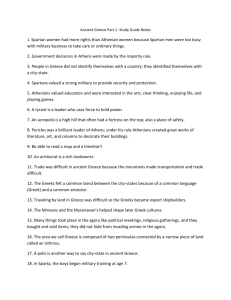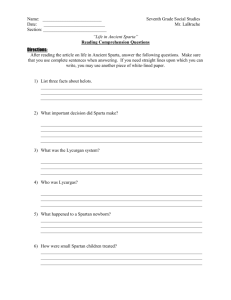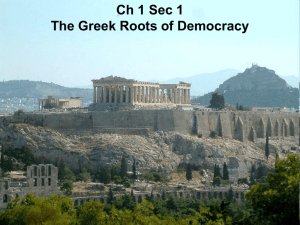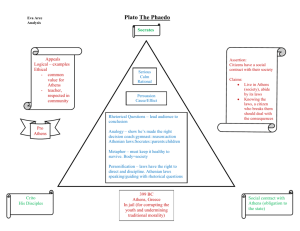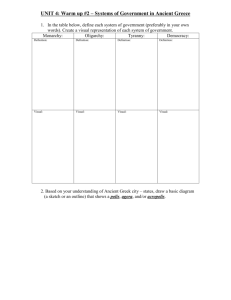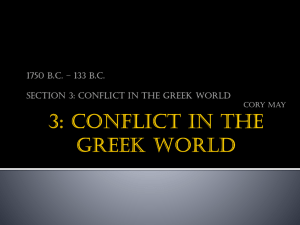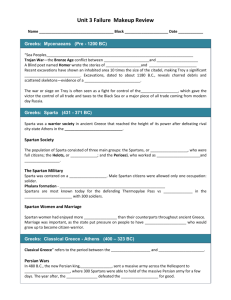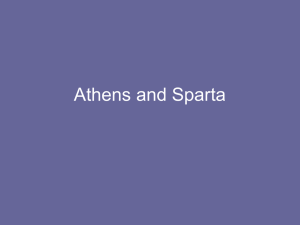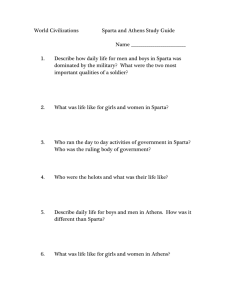athens & sparta - Columbia Games
advertisement
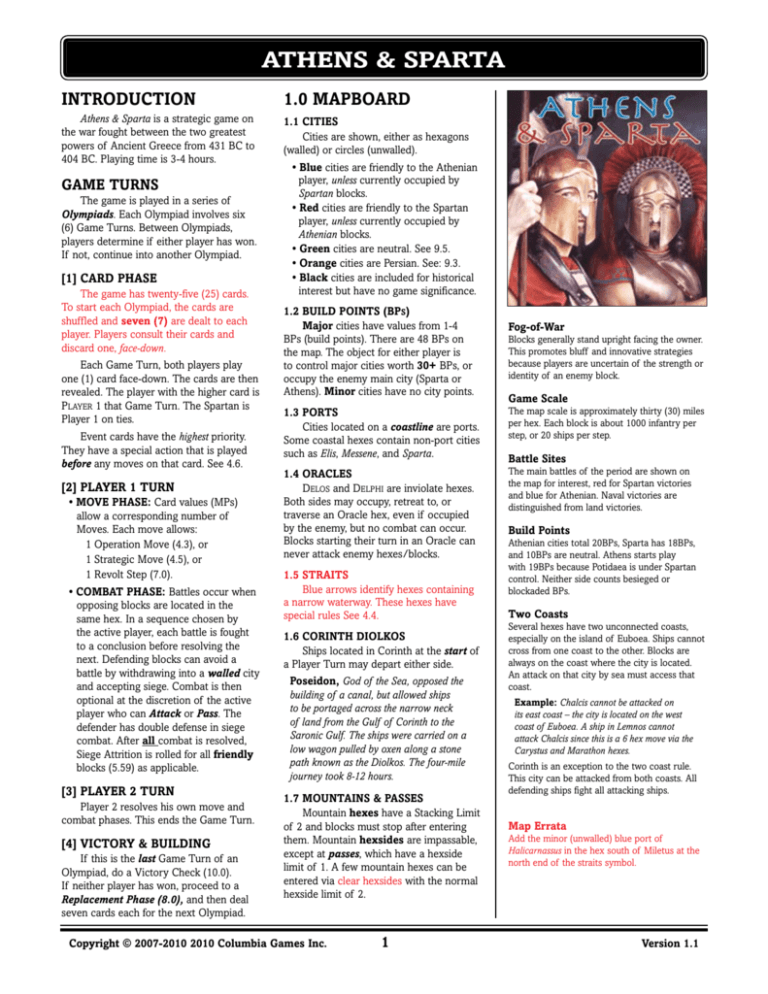
ATHENS & SPARTA INTRODUCTION 1.0 MAPBOARD Athens & Sparta is a strategic game on the war fought between the two greatest powers of Ancient Greece from 431 BC to 404 BC. Playing time is 3-4 hours. 1.1 CITIES Cities are shown, either as hexagons (walled) or circles (unwalled). • Blue cities are friendly to the Athenian player, unless currently occupied by Spartan blocks. • Red cities are friendly to the Spartan player, unless currently occupied by Athenian blocks. • Green cities are neutral. See 9.5. • Orange cities are Persian. See: 9.3. • Black cities are included for historical interest but have no game significance. Game Turns The game is played in a series of Olympiads. Each Olympiad involves six (6) Game Turns. Between Olympiads, players determine if either player has won. If not, continue into another Olympiad. [1] Card Phase The game has twenty-five (25) cards. To start each Olympiad, the cards are shuffled and seven (7) are dealt to each player. Players consult their cards and discard one, face-down. Each Game Turn, both players play one (1) card face-down. The cards are then revealed. The player with the higher card is Player 1 that Game Turn. The Spartan is Player 1 on ties. Event cards have the highest priority. They have a special action that is played before any moves on that card. See 4.6. [2] Player 1 Turn • Move PHASE: Card values (MPs) allow a corresponding number of Moves. Each move allows: 1 Operation Move (4.3), or 1 Strategic Move (4.5), or 1 Revolt Step (7.0). • Combat PHASE: Battles occur when opposing blocks are located in the same hex. In a sequence chosen by the active player, each battle is fought to a conclusion before resolving the next. Defending blocks can avoid a battle by withdrawing into a walled city and accepting siege. Combat is then optional at the discretion of the active player who can Attack or Pass. The defender has double defense in siege combat. After all combat is resolved, Siege Attrition is rolled for all friendly blocks (5.59) as applicable. [3] Player 2 Turn Player 2 resolves his own move and combat phases. This ends the Game Turn. [4] VICTORY & BUILDING If this is the last Game Turn of an Olympiad, do a Victory Check (10.0). If neither player has won, proceed to a Replacement Phase (8.0), and then deal seven cards each for the next Olympiad. 1.2 BUILD POINTS (BPs) Major cities have values from 1-4 BPs (build points). There are 48 BPs on the map. The object for either player is to control major cities worth 30+ BPs, or occupy the enemy main city (Sparta or Athens). Minor cities have no city points. Fog-of-War Blocks generally stand upright facing the owner. This promotes bluff and innovative strategies because players are uncertain of the strength or identity of an enemy block. Game Scale 1.3 Ports Cities located on a coastline are ports. Some coastal hexes contain non-port cities such as Elis, Messene, and Sparta. The map scale is approximately thirty (30) miles per hex. Each block is about 1000 infantry per step, or 20 ships per step. 1.4 ORACLES Delos and Delphi are inviolate hexes. Both sides may occupy, retreat to, or traverse an Oracle hex, even if occupied by the enemy, but no combat can occur. Blocks starting their turn in an Oracle can never attack enemy hexes/blocks. The main battles of the period are shown on the map for interest, red for Spartan victories and blue for Athenian. Naval victories are distinguished from land victories. 1.5 STRAITS Blue arrows identify hexes containing a narrow waterway. These hexes have special rules See 4.4. 1.6 CORINTH DIOLKOS Ships located in Corinth at the start of a Player Turn may depart either side. Poseidon, God of the Sea, opposed the building of a canal, but allowed ships to be portaged across the narrow neck of land from the Gulf of Corinth to the Saronic Gulf. The ships were carried on a low wagon pulled by oxen along a stone path known as the Diolkos. The four-mile journey took 8-12 hours. 1.7 MOUNTAINS & PASSES Mountain hexes have a Stacking Limit of 2 and blocks must stop after entering them. Mountain hexsides are impassable, except at passes, which have a hexside limit of 1. A few mountain hexes can be entered via clear hexsides with the normal hexside limit of 2. Copyright © 2007-2010 2010 Columbia Games Inc. 1 Battle Sites Build Points Athenian cities total 20BPs, Sparta has 18BPs, and 10BPs are neutral. Athens starts play with 19BPs because Potidaea is under Spartan control. Neither side counts besieged or blockaded BPs. Two Coasts Several hexes have two unconnected coasts, especially on the island of Euboea. Ships cannot cross from one coast to the other. Blocks are always on the coast where the city is located. An attack on that city by sea must access that coast. Example: Chalcis cannot be attacked on its east coast – the city is located on the west coast of Euboea. A ship in Lemnos cannot attack Chalcis since this is a 6 hex move via the Carystus and Marathon hexes. Corinth is an exception to the two coast rule. This city can be attacked from both coasts. All defending ships fight all attacking ships. Map Errata Add the minor (unwalled) blue port of Halicarnassus in the hex south of Miletus at the north end of the straits symbol. Version 1.1 ATHENS & SPARTA 2.2 BLOCK TYPES 2.21 Hoplites ���� infantry Heavily armored C3 bearing a long spear, heavy shield, and sword. They ATHENS ATHENS mostly fought in a tight 3 4 formation called a phalanx. Spartan hoplites have the highest combat ratings. Each step is 1000 men. ��� 5 4 ATHENS C3 � 4 ���� � � 3 � �� ��� ATHENS B2 4 ATHENS ��� Strength 2 Strength 3 B2 ���� Strength (4) 5 RHODES C3 ��� A1 ��� ��� 4 ATHENS ��� A1 �� ATHENS C3 ��� 3 COMBAT (C3) ���� B2 �� A1 3.1 NEUTRALS � � �� � CHALCIS Replacement Pool: an off-map area where each player keeps undeployed blocks, hidden and standing upright. � 4 ATHENS BLOCK DATA �� � �� ��� 3 �� � ��� RHODES � � CHALCIS A1 4 RHODES Home City 4 (Athens) � � � A1 ATHENS � 3 MOVE (4) Version 1.1 C3 ��� �� ���� B2 �� Strength 1 Note: Potidaea is controlled by Sparta, but besieged and blockaded by Athens. Neutral cities (9.5) and blocks are green. The blocks are kept off-map and enter play only if their city becomes an ally of one player. Both players may command green blocks. ��� �� � � �� ��� �� � • All Reserve Blocks • Demos/Helots/Tyrants • Spartan ships Chios, Mytilene, Corcyra and Rhodes (all have blue stars). 2 � �� Set-up blocks on their Home Cities at maximum strength. The following blocks are not deployed: Copyright © 2007-2010 Columbia Games Inc. � �� � CHALCIS Step Reduction 3.0 DEPLOYMENT � 5 ATHENS �� � � �� � �� �� The city state where that block originates. New blocks must be deployed at their home city, except Reserve blocks may be deployed in any Major City. C3 ��� 2.14 Home City Olympic Games were held in 432 (83rd Olympiad), and every four years during the war. The city state �� of Elis managed and judged the games. Sparta was banned from the 420 games for violating the “sacred truce”. In Olympic calendar terms, the war began in ��� 1/84 and A1 ended in 4/89. Oar and sail��� powered A1 triremes that all navies used at this time. Each ATHENS RHODES ship carried 4 4 160 rowers, 20 sailors, and 20 hoplites or peltasts. Each step is 20 triremes. Athenian ships have the higher combat ratings. ���� �� A block’s Move Limit indicates how many hexes it may move. Blocks can always move less hexes than this limit. A1 2.24 Ships 2.12 Combat Rating 2.13 Move Limit Pericles had no idea it was 431 BC when the war started, nor did Lysander know it was 404 BC when it ended. These are “Before Christ” dates on our Julian, solar calendar. Greek city states had their own lunar calendars, many with unique names for �� months and days. There was, however, one calendar on which all Greeks agreed, one that tracked the Olympic Games beginning in 756 BC. On this calendar, Olympiads were counted every four years. �� �� Blocks vary in maximum strength. Some blocks have four steps, some three steps, some two steps. For each hit taken ��� B2 in combat, strength is reduced one step by rotating the block 90 degrees counterclockwise. The sidebar shows a block at ATHENS strength 1, 2, and 3. 3 Example: a block rated B1 only scores a hit for each “1” rolled, but a block rated B3 scores one hit for each 1, 2, or 3 rolled. The Olympic Calender Horses required extensive pasture, available only in Euboea, Boeotia, and CHALCIS Thessaly. Greek horses 5 were really ponies 13 to 14 hands high, and the riders were lightly armed with a spear, javelins, and a curved sword. Cavalry were effective for pursuit and harrying. Each step is 400 men. ��� A1 The Combat Rating is indicated by a letter and number, such as A1 or B2. The letter determines when a block attacks. All A blocks attack first, then all B blocks, then all C blocks. The number indicates the maximum roll that will score a hit. �� ��� A1 �� C3 Founded as a colony of Corinth, Potidaea came under Athenian control as a member of the Delian League. Corinth sought to recover her colony in 432, occupying the city, provoking the war. The game starts with Potidaea under siege and blockade by Athenian forces. Potidaea is located on the Gulf of Therma and has no access to the Gulf of Torona. 2.23 Cavalry The current strength of a block is the number of diamonds on the top edge when the block is standingRHODES upright. ATHENS 4 4 Strength determines how many six-sided dice (d6) are thrown for a block in combat. A block at strength 4 rolls 4d6 (four sixsided dice); a block at strength 1 rolls 1d6. ��� �� ATHENS 2.11 Strength ���� ��� �� Blocks have numbers and symbols defining movement and combat abilities. 5 Potidaea A variety of��� light A1missile troops, including javelin, archers, and slingers. They CHALCIS for pursuit RHODES proved 5effective 4 and pillaging and became more numerous than hoplites as the war progressed. Each step is 1000 men. ��� 2.1 block DATA B2 4 2.22 Peltasts ��� �� • Blue labels on blue blocks • Red labels on red blocks ���� • Green��� labels B2 on green blocks C3 The blocks add surprise and secrecy to the game; when standing upright, type and ATHENS ATHENS strength 3 is hidden from the 4opponent. ��� B2 � ��� Athens & Sparta really covers the Second Peloponnesian War. The First Peloponnesian War, ��� ��� A 1 A1 fought 460-445 BC by the same powers, ended with a "Thirty Year Peace". But after an uneasy truce of 14 years, urged on by Corinth and Thebes, Sparta RHODES again decided to curb theCHALCIS Athenian Empire. �� The blocks represent Athenian (blue) and Spartan (red) forces and their respective allies. A sheet of die-cut labels is included. One label must be attached to the face of each block. Lightly position each label, ensure it is straight, and then press firmly to the block. The First Peloponnesian War � 2.0 ARMIES � ATHENS & SPARTA 4.0 MOVEMENT Players are not compelled to Move. They may expend all MPs on Revolts, or do nothing. Blocks can move only once per Player Turn, except to Retreat or Regroup. 4.1 Terrain Limits Terrain affects how many ground blocks can stack in one hex, and how many can attack through each hexside. These effects are noted on the Terrain Effects table (sidebar). NOTE: Stacking Limits are ignored when moving. Hexside Limits are ignored unless attacking. Ground blocks cannot cross water except where a Strait is shown (4.4), or by Sea Move (4.52). Ships cannot cross land hexsides, but see 1.6 (Corinth Diolkos). 4.2 HEX Control Neutral hexes have green cities. Friendly hexes contain a friendly city or are occupied by friendly blocks. Enemy hexes are those friendly to the enemy. Contested hexes have an unresolved battle pending. Important: Hex control changes at the end of each Phase. Hence, players cannot move into a hex and then claim it is friendly for further moves in the same Move Phase. Moving through a hex does not change control. Sieges modify Hex Control (5.51). 4.3 OPERATION Moves Operation moves apply to both ground blocks and ships. For 1MP, one block can move up to its Move Limit in hexes: Hoplite: Peltast: Ship: Cavalry: 3 hexes 4 hexes 4 hexes 5 hexes Example: Assuming 3MP, a player can move a total of three blocks. These can all be in one hex or in multiple hexes. The Spartan player might, for example, move 2 hoplites from Sparta to Corinth and also one ship from Gytheum to Athens. Blocks may pass freely through friendly blocks, but must stop and fight a battle when they enter any hex containing enemy block(s), regardless of type. Ships stack with ground blocks in coastal hexes and are included in stacking and siege limits. Ships can fight in any coastal hexes, but must end their Combat Phase in a friendly port (or on blockade) – retreat or regroup as necessary. 4.4 Straits Straits have special movement and combat rules. Blocks defending a straits hex are located on the city side, but have land and sea control of the entire hex. Blocks entering an enemy-occupied straits hex must stop. Vacant straits have no effect on ship movement. Ground blocks entering a vacant straits hex must stop if they are crossed, otherwise not. See Example 1. Sea control is not required to Move across a strait, but is required to Attack across a strait. Since the defender has default sea control of a straits hex, an attack across a strait requires a ship and will be delayed or prevented if the defender also has a ship. If the defending ship is defeated in Round 1 ship combat, a ground block can cross a strait and fight on its next combat turn. See Example 2. Hexside limits of straits hexes can vary. When defending blocks are on the opposite side of a straits, attacking blocks have hexside limit 1. Otherwise, the hexside limit is normal for the terrain. See Example 3. 4.5 STRATEGIC Moves One strategic move costs 1MP. There are two types of strategic move: 4.51 March Move: ground blocks move up to double their normal move. Movement through Neutral or Vacant hexes is allowed, but March Moves must end in Friendly hexes. 4.52 Sea Move: ships or ground blocks may move from one Friendly port to any other Friendly port. Strategic Movement can never be used to move to/from a siege or blockade, enter enemy or contested hexes, retreat, or regroup. A block may never move by land and by sea in the same Player Turn. 4.6 CARDS All cards contain a number of MPs (move points). Some cards also have a written event which is played before any normal moves on that card. Event cards have the higher priority for determining the sequence of player turns. Some events affect both players. Terrain Effects TERRAIN Clear Strait STACK 4 2 HEXSIDE 1 4 2 1/22 Pass • 1 Mountain3 2 04 Rivers No Effect 1. Athens is Stack 6 (maximum 4 ground blocks). 2. Stop when entering if crossing the strait. Hexside 1 if attacking across the strait. 3. Stop when entering. 4. Mountain hexsides are impassable. This means most mountain hexes are unplayable as they cannot be entered. Playable mountain hexes require at least one clear hexside. Thasos is NOT a mountain hex. Operation Movement To preserve "fog-of-war" ships are stopped by ground blocks, and vice-versa. Group and Muster moves do not exist in this game. Each move applies to one block, not one group. Strategic Movement Strategic sea moves allow any blocks to move from one side of the map to the other, provided the destination is a friendly port and they do not pass through enemy hexes. Strategic movement to/from sieges or blockades is prohibited. Straits Example 1: Moving from Samos to Ephesus crosses a strait and blocks must stop even if Ephesus is vacant. Moving from Miletus to Ephesus does not cross a strait, so a block need not stop (unless Ephesus is enemy-occupied) and can move on to Notium. Example 2: Two hoplites attack Abydos, one from Cardia one from Lampsacus, plus a ship from Lemnos. Abydos is defended by a peltast and a ship. In round 1, the ships fight a naval battle and the defending peltast fights the hoplite from Lampsacus only. The hoplite from Cardia can not cross the strait round 1 because the enemy has sea control. If the defending ship is eliminated or withdrawn in round 1, the Cardia hoplite can cross the strait and attack in round 2. Otherwise, the hoplite cannot cross the strait and returns to Cardia. Example 3: There are four hexsides into the Heraclea hex. Two of them are clear, with hexside limit 2. Attacking from Thebes via the Thermopylae Pass is hexside 1. To attack Heraclea from Chalcis requires the strait to be crossed with hexside limit 1. EXAMPLE: One player plays a "5" and the other plays "2/Storm". The Storm card is played first but (in this case) the event affects both Player Turns. Copyright © 2007-2010 Columbia Games Inc. 3 Version 1.1 ATHENS & SPARTA 5.0 BATTLES 5.3 Retreats BATTLE (Example) Battles are fought after all movement is completed. Each is fought for one or two Combat Turns which must be completed before fighting the next. The active player determines the sequence of battles and need not commit to any sequence in advance. Blocks can only retreat when it is their combat turn, provided they do not fire that turn. Per combat round, a maximum of two (2) blocks may retreat per clear hexside, and one (1) block via other passable hexsides. Blocks that cannot retreat when required are eliminated. Blocks are not revealed until each battle is fought. Reveal blocks by tipping them forward to maintain current strength. The attacker first reveals all blocks in a selected battle. Ground blocks must retreat to friendly or vacant adjacent hexes. Attacking blocks must retreat via hexsides used to start the battle; defending blocks via any other hexsides. Neither player can retreat to enemy-occupied or contested hexes. Blocks can retreat to a hex besieged by the same player. Retreat into a straits hex requires sea control (6.6). In a walled city the defender can withdraw into siege (5.5) before combat. Otherwise, reveal defender blocks and resolve the battle. 5.1 Combat turns Each block has one combat turn per combat round to Fire or Retreat. The sequence of combat turns depends on combat ratings. All “A” blocks go before all “B” blocks, which go before all “C” blocks. All defending blocks with the same rating go before attacking blocks. Example: Hoplite B2 and Peltast A1 attack a Hoplite B2 and Ship C3. The sequence for each combat round is Peltast A1, defending Hoplite B2, attacking Hoplite B2, then Ship C3. After all blocks have taken one combat turn, repeat sequence for a second round. Unless the defender is eliminated or retreats, the attacker must retreat after Round 2, taking one extra fire (pursuit) from defending Peltasts and Cavalry. 5.2 COMBAT HITS A block fires by rolling as many dice as its current Strength. A hit is scored for each die roll equal or lower than the block’s combat rating. Example: Hoplite at strength 4 rolls 4 dice. It has B3 combat, meaning all rolls of 1, 2, & 3 are hits. Rolls of 4, 5, & 6 are misses. If the rolls are 1, 2, 4, & 5, the Hoplite scores two hits and two misses. Enemy blocks cannot be targeted. Each hit reduces the strongest enemy block at that instant. When two or more blocks share the highest strength, the owner chooses which to reduce. Note: combat is not simultaneous. All hits are applied immediately. Ships must retreat (not via enemy hexes) to a friendly port within four hexes. Hexside limits are ignored. 5.4 REGROUPS Victorious ground blocks of a battle or siege may immediately regroup to adjacent friendly or vacant hexes. Hexside limits (2 clear/1 rough) apply. Victorious ships may regroup 1–4 hexes to a friendly port (not via enemy hexes). Hexside limits are ignored. Blocks cannot regroup to a contested hex. They can regroup to an existing and friendly siege hex, but cannot storm (5.53) in that siege on the same Combat Phase. Declaration: Sparta reveals blocks. Athens chooses to accept battle, hoping to survive two combat rounds and force Sparta to retreat. Round 1 1. Athenian peltast 2A1 misses. 2. Spartan peltast 4A1 scores one hit, which must be taken on the Athenian hoplite. 3. Athenian hoplite 2B2 scores one hit, taken on the Spartan peltast. 4. Spartan hoplite 4B4 scores two hits, leaving a peltast 1A1 and hoplite 1B2. Round 2 1. Athenian peltast withdraws into city. 2. Spartan peltast 3A1 misses. 3. Athenian hoplite withdraws into city. 4. Spartan hoplite 4B4 storms the city and scores two hits, which counts as one hit (double defense). Athenian peltast is eliminated. Athens now holds the city with a hoplite 1. Each Spartan block has the option to Besiege or Retreat. Sparta elects to Besiege with both blocks and rolls Siege Attrition (4+) for them. Retreats/Regroups Blocks can retreat/regroup to vacant enemy cities. Hence, an Athenian peltast attacking Messene from Pylos can retreat back to a vacant Pylos should the attack fail. This is important because Pylos reverts to Sparta at the end of the movement phase. Battle Sequence 5.5 SIEGES In a walled city the defender has the option to fight a battle outside the city, or withdraw into the city and accept siege. Some blocks may accept battle while others accept siege. If the defender chooses to fight, blocks may later withdraw to the city on their combat turn. If all defenders accept siege, the attacker can Storm or Besiege. Besieging blocks are always left face-up. Important: Ships cannot besiege (except islands); they blockade (6.7). 5.51 Siege Control A siege hex is friendly to the attacker for movement, but friendly to the defender otherwise. Hence, the attacker can move a ground block through a besieged hex. Important: Naval operations in a port hex are controlled by the Defender unless the Attacker has a ship on Blockade. The player with Sea Control can move ships (operationally) through the port hex, or retreat/regroup there. Copyright © 2007-2010 2010 Columbia Games Inc. Sparta attacks Amphipolis with a Hoplite 4B4 and Peltast 4A1. Athens defends with a Hoplite 3B2 and Peltast 2A1. 4 The sequence to resolve multiple battles is an important part of play. The result of one battle can affect regroups and retreats in later battles. Sieges The decision to accept siege in a walled city grants the Defender double defense, but it also means the Attacker can remain in the hex to besiege after two rounds of combat. Athens' Long Walls Athens had two parallel walls, three miles long, linking the walled city to its fortified port. Provided control of the sea was kept, the walls ensured that no enemy army could starve Athens from her critical grain imports. Spartan Walls Athens, Corinth, and Thebes were all fortified with high, thick walls. Spartans considered such defences "unmanly". Earthquakes This event cancels the Game Turn for both players except for Siege Attrition. Player 1 rolls for each Siege Attrition first. Player 2 need not roll for a siege that has ended because of a Player 1 roll. Version 1.1 ATHENS & SPARTA 5.52 Siege Limits 5.58 Pillage City size (1.2) restricts the number of blocks that can accept a siege: Major: 4 blocks Minor: 2 blocks Extra blocks must fight a normal battle outside the city. When a major city is captured, the victor receives pillage BPs equal to the city's BP value. These BPs must be spent on victorious blocks that do not regroup. Athens: has a stacking, siege, and attack limit of six blocks, with a maximum of four ground blocks. 5.53 Siege Attacks – Storming The block limit to attack is equal to the Siege Limit. Hence, a maximum of four (4) blocks can attack a major city, and two (2) a minor city. An attack cannot begin until all defenders have withdrawn into the city. NOTE: When first storming, the current combat round restarts to allow all blocks a combat turn, but no block can get two combat turns in the same round. Non-attacking blocks do not fire or take hits. Subject to Siege Limits, the attacker may substitute blocks after Round 1 and attack with them on Round 2. 5.54 Siege Defense Besieged blocks in walled cities have Double Defense (D2); two hits are required to lose one step. Each hit is treated as a half-hit and the next hit must be taken on that same block. A half-hit remaining at the end of a Siege Attack is recovered. 5.55 Relief Forces Subject to hex stacking, the defender may attempt to relieve a siege by attacking into the hex with external forces. A normal battle is fought with the besieging player on defense, and the relief force on offense. Relief forces can be helped by sallying forces. Relief ground forces cannot withdraw into the city, but relief ships can. 5.56 Sallying Defending blocks have the option to Sally in their own Combat Turn instead of firing. This is an attempt to break a siege or assist a relief force. For all future Combat Turns, sally blocks fire on offense and forfeit double defense. Sallying blocks cannot retreat except to withdraw back to the city. Exception: sallying ships may "run a blockade" and retreat normally beginning on their Combat Turn after sallying. 5.57 Cavalry in Siege In Siege Combat, whether attacking or defending, cavalry fight with reduced firepower of B1. They have normal firepower to Sally (5.56). Siegecraft 5.59 Siege Attrition Siege Attrition rolls are made by the active player for all friendly blocks in a siege or blockade. Each block rolls 1d6. Rolls that equal or exceed a target number (below) are hits, taken on the highest strength block(s) as normal. Target numbers for defender siege attrition depend on whether the attacker has a "Half-Siege" or a "Full-Siege". Half-Siege: siege or blockade. Full-Siege: siege and blockade. Status Defender Attacker Half-Siege 5+ 4+ Full Siege 3+ 4+ Blockade of an island (6.7) is a full-siege. Siege of a landlocked city (no port) is a full-siege. 6.0 SHIP COMBAT 6.1 SHIP Attacks An Operation Move by ships to an enemy-occupied hex must originate in one or more friendly ports within 4 hexes. Ship attacks can be combined with ground attacks, keeping in mind that ground blocks cannot cross sea hexsides. 6.2 NAVAL BATTLES The attacker reveals all attacking ships. The defender either accepts battle (reveal blocks) or withdraws to siege (walled cities only). Some defending blocks can fight while others accept siege. If the defender reveals no ships, the Attacker can either declare Shore Combat or Blockade. If the defender reveals one or more ships, a naval battle takes place. These are fought like any other battle. The attacker must defeat the defending ships before Shore Combat or Blockade can be declared. Combat turns resolving a naval battle do count toward the normal two round battle length. Few sieges during the Peloponnesian War ended with the attacker taking the city by assualt. Siegecraft was primitive, consisting mainly of scaling ladders, battering rams, earth ramps, and mining. The lack of good local timber and rocky soils made none of that easy. Siege towers, catapults, and ballistae were inventions for the next century. Most cities surrendered on terms (sometimes after several years of investment), or because of internal revolt and treachery. Sieges always meant significant losses from disease, desertion, and exposure for both sides. Siege Attrition At the start of play, Athens has Potidaea under siege and blockade. This is a full siege. Sparta rolls at 3+ for each block at the end of each Spartan turn. Athens rolls at 4+ at the end of each Athenian turn. If either the ship or hoplite leaves or is eliminated, this is a "half-Siege" and the Spartan roll is now made at 5+. Half-siege means a city still has supply either by sea (no blockade) or by land (no ground siege). Athens could survive a Spartan ground siege by maintaining her sea supply. Sparta won only when she was able to blockade Athens and mount a full-siege. Sallying Sallying blocks do not fire on the turn they sally. They take hits normally (no double defense) and are deemed to be on offense. Enemy blocks are on defense, but do not have double defense and cannot Storm while being sallied. In effect, the besieged player starts a field battle to try and break-out, or assist a relief force. Shore Combat Ships were often destroyed on shore, most notably at Cyzicus and Aegospotami, the warwinning Spartan victory in 405. Fortified Ports Most walled port cities had fortified harbors where ships could be protected from enemy naval action. These were typically beaches with flanking defensive towers and a floating barrier or chain to seal access. Landlocked Cities Cities like Elis, Messene, Sparta, and Thebes are not ports. These hexes cannot be blockaded by ships, but also cannot benefit from supply by sea. They are subject to full-siege when besieged only by ground blocks. When ships and ground blocks exist in the same battle, the ground blocks fight a simultaneous land battle while ships fight the naval battle. Copyright © 2007-2010 Columbia 2010 Columbia Games Games Inc. Inc. 5 Version 1.1 ATHENS & SPARTA 6.3 Shore Combat 6.8 Islands Attacking ships can declare Shore Combat at the beginning of any combat round if there are no defending ships. Shore combat occurs at normal firepower and ships can take hits from ground blocks. If a hex has six Sea Hexsides (Naxos) or is an island accessed by a strait (Corcyra), or is an island with only one port (Cephallenia) then a blockade of the port is a full siege. Defending ships may not decline combat with ground blocks. They can retreat or withdraw to siege or blockade only in their own combat turn. 7.0 Revolts 6.4 Ships in Siege In Siege Combat, whether attacking or defending, all ships fight with reduced firepower of C1. They have normal firepower to Sally (5.56). 6.5 Ship Retreats/REGROUPS Ships ignore hexsides when retreating/ regrouping. They go to a friendly port within four hexes (avoiding enemy hexes). Ground blocks cannot Sea Retreat/Regroup. 6.6 Sea Control Ships exert sea control of their hex. The defender has sea control of a hex unless blockaded. Neither player has sea control of a vacant hex. 6.7 BLOCKADES Attacking ships have the option to declare a Blockade (half-siege) of an enemy port city. Ships cannot blockade if an enemy ship is present, unless that ship has withdrawn to siege. A blockade can begin in the declaration phase (before combat), or by withdrawing to blockade in a combat turn, or after the 2nd combat round (instead of retreating). Blockading ships remain face-up and roll for Siege-Attrition (4+) at the end of each friendly Player Turn. Operation Moves are required to enter or leave Blockade hexes. The blockading player can use Operation Moves to move ships through blockade hexes, and can Retreat/Regroup ships to/from a blockade. Ground blocks may not attack blockading ships. Players may try to break a blockade by attacking and/or sallying (5.56) with ships. A normal ship battle is fought with the blockading player on defense. Relief ships can withdraw into the city on their normal turn. Defending ships may retreat on their Combat Turn to Blockade their own hex, even if currently besieged. Such a maneuver when enemy ships are present is the same as a Sally (5.56). SEA ATTACK (Example) Revolts are sponsored by spending move points (MPs) to deploy a Tyrant or Demos block in an enemy major city. The block's strength is set by the number of moves spent (Tyrant 3 costs 3 MP). Revolts are not allowed in minor cities. IMPORTANT: Athens and Sparta are immune to revolts. Neutral cities are also immune until they join one player. Revolts are automatically successful in a vacant enemy major city. Otherwise, they are resolved as normal battles. Exception: the revolt block always inflicts full hits (no double defense) on besieged defenders. All defending blocks (including ships) can help defeat a revolt. Other attacking blocks may also participate, firing normally, but cannot take hits until after they fire. The revolt block does not count toward stacking, hexside, or siege attack limits. If a revolt succeeds (city is captured) the block is exchanged for a reserve peltast or hoplite at the same strength from the replacement pool. If the revolt fails, the block is eliminated. In either case the revolt block can be used again as desired, but never against the same city in the same Olympiad. 7.1 Helot Revolts The Spartan city of Messene can be targeted for revolt by the Athenian player. Instead of the Demos block, the Helot is deployed at its desired strength (1MP per step) at Messene to fight a normal battle. Other friendly blocks can assist the revolt by a normal attack. Exception: the Helot cannot retreat and is eliminated if any defenders remain after two rounds of battle. A victorious Helot remains on the map and is treated like any other block for the rest of the game. If eliminated, the Helot cannot revolt again in the same Olympiad. Copyright © 2007-2010 Columbia Games Inc. 6 Sparta attacks Naupactus with ship 3C2 from Leucas, peltast 3A1 from Corinth, and hoplite 3B3 from Thebes. Athens has peltast 3A1 and ship 3C3. Declaration: Sparta reveals blocks. Athens chooses to accept battle. Corinth peltast must cross strait to attack Naupactus. Since both sides have ships, a separate ship battle occurs. Round 1 1. Athenian peltast (3A1) misses. 2. Corinth peltast cannot fire because the straits are under Athenian sea control. 3. Thebes hoplite (3B3) scores two hits, which must be taken on the Athenian peltast. 4. Athenian ship (3C3) could fire, retreat, or withdraw to siege. It choses to fire, scoring two hits, which must be taken on the Spartan ship. 5. Spartan ship (1C2) retreats to Corinth. Round 2 1. Athenian peltast (1A1) withdraws into city. Since all Athenian ground blocks have accepted siege, the Spartan can storm. 2. Corinth peltast (3A1) still cannot fire. 3. Spartan hoplite (3B3) storms and scores two hits, eliminating the Athenian peltast and capturing the city. 4. Athenian ship (3C3) could now fight in shore combat, retreat, or blockade. Athens elects to blockade, ending the battle and forcing the Spartans to make a halfsiege roll. Athenian ship does not roll for blockade until the end of its own turn. Note: What if the Athenian peltast and ship accepted siege in the declaration phase? The Spartan ship would then have sea control and the Corinth peltast would have been able to cross the strait to attack. The ship could also attack, but only at C1 for siege combat. With double defense, the defending peltast and ship would likely have survived the battle. Sparta could have ended with a full-siege of Naupactus, but could also elect to regroup to avoid Siege Attrition. Revolts Throughout the war there was an internal struggle between Tyrants and Democrats in most city states. The Democrats favored Athens, the Tyrants favored Sparta. Assassinations and executions dominated the civic scene throughout the war. Both sides faced revolts, especially Sparta after the Peace of Nicias, and Athens after the Syracuse disaster. The Athenian Empire was more vulnerable to revolts, and this difference is reflected in the higher combat rating of the Tyrant block. Note that revolts in a vacant major city are automatic. Worse, the rebel city may be used as a destination for enemy strategic movement unless recaptured quickly. Leaving any major city unguarded is unwise. Version 1.1 ATHENS & SPARTA 8.0 REPLACEMENTS At the end of each Olympiad, both players have a simultaneous Replacement Phase. Steps can be added to existing blocks, and new blocks can be built. 8.1 BUILD Points (BP) Both players total the value of cities under their control, including Neutral cities. These points are then expended as desired except the maximum BPs that may be spent per major city is 2x the city value, and the maximum per minor city is 1BP. Athens & Sparta have build limits of 8BPs. Important: Besieged or Blockaded cities provide no BPs for either player. 8.2 Reinforcements Reinforcing is adding one or more steps to existing blocks on the map. Blocks in a non-city hex cannot be reinforced. Blocks involved in a siege or blockade (attack or defense) cannot be reinforced. 8.3 New Blocks New blocks are chosen from a player's Replacement Pool. They must be built in their Home City, but not if enemy-held. Reserve blocks are built in any friendly city, subject to BP limits (8.1). 8.4 Block costs Cost per step varies with type. 1BP Peltasts & Hoplites 2BP Cavalry & Ships 8.5 ELIMINATED BLOCKS Blocks are not permanently eliminated. Place them in the Replacement Pool where they can be built again normally. 8.6 DISBANDING Players cannot merge blocks on the map. They may disband any block on the map and move it to their Replacement Pool. Steps on disbanded blocks are forfeit, but the blocks can be rebuilt immediately at normal BPs. 9.0 Strategics 9.1 Hellespont Athens imported grain from Black Sea colonies to feed her large population. Abydos was a choke point for this trade. Spartan sea-control (6.6) of Abydos requires Athens to remove any one block from those located in Athens at the end of every Athenian Player Turn. 9.2 SICILY The Peace of Nicias Sicily and Syracuse are represented by one "off-board" area (ignore hexes). There is no stacking limit for Sicily, but the normal Storm Limit of 4 does apply. In 421, after ten years of fighting, Athens and Sparta made a "50 year peace", but the war essentially continued in proxy form. Sparta first declined to return Amphipolis to Athens, which then refused to give back Pylos. In 418, Sparta took exception to a defense alliance of Argos, Elis, and Megara. Sparta invaded and defeated Argos at the Battle of Mantinea. Athens had sent 1000 hoplites to Argos honoring a previous treaty obligation and just 300 survived the battle. Athens then launched her disastrous attack on Syracuse. The "peace" ended in 413 when Sparta secured Persian aid and openly resumed the war. Movement to/from Syracuse must be made via a friendly (unblockaded) Corcyra, Leucas, Cephallenia, or Cyllene. Each of these embarkation ports is marked by a black ship labeled "Sicily". One MP is required to move each block. Important: both players may move and attack with ground blocks by sea, regardless of Sea Control. This is allowed only in Sicily. Sieges in Syracuse are fought normally. Syracuse blocks may withdraw into siege in the declaration phase, or later in any combat turn if they do not fire. Battles in Syracuse are ongoing. That is, after two rounds of combat, the attacker is not forced to retreat and there is no pursuit fire. A battle continues for unlimited player turns of two combat rounds. The active player may attack (on offense) or pass. Siege Attrition applies normally. EXCEPTION: Attacking blocks roll for Siege Attrition at 3+ if the Defender of Syracuse has sea control (see 6.6). If the Attacker establishes a full siege, defending blocks arriving from embarkation ports are a relief force (5.55}. Neither player can regroup or retreat to/from Syracuse. Returning from Sicily to one of the four embarkation ports requires a normal move (1MP per block). Syracuse was an important food source for Corinth. If Syracuse is blockaded or captured by Athens, all enemy blocks located in Corinth roll for Siege Attrition (5+) at the end of each Spartan turn. If Syracuse is captured, and sea control is maintained, Athens is immune to the effects of Hellespont (9.1) supply attrition. 9.3 PERSIA Persian cities (orange) are neutral. If Sparta gains control of Miletus Persian support becomes available. Persian support lowers the cost of all Spartan (and allied) ships to 1BP per step. Persian support is optional for Sparta but irrevocable. The price for Persian support is that Miletus becomes Persian after the war and its 2BP cannot be counted by the Spartan player for victory purposes. Persian support ceases (permanently) should Athens regain control of Miletus. Copyright © 2007-2010 2010 Columbia Games Inc. 7 Syracuse Syracuse, founded by Corinth, was the most powerful city on Sicily, and second only to Athens in wealth. Although Syracuse was neutral, she effectively supported Sparta by exporting grain to Corinth – a staunch Spartan ally. Athens sent a small force to Sicily in 427 BC to support her allies, but left one year later, unable to continue a war against both Sparta and Syracuse. During the Peace of Nicias the issue of Syracuse again arose and, in 415, a fateful decision was taken to mount a major attack. Due to poor Athenian generalship and logistics, and good defense by Syracuse with Spartan aid, the expedition turned into a disaster. Athens lost over 200 ships, 40,000 crew, 10,000 hoplites, and 10,000 peltasts, crippling her for the remainer of the war. Syracuse BP (Recommended) After the first deal, both players allocate one card face-down at Sicily, leaving only five cards for the first Olympiad. The sum of the two cards becomes the Build Points for Syracuse (instead of the standard 4BP). The cards are not revealed until Syracuse is attacked. Once revealed, the cards remain face-up for the remainder of the game. Persia Athens' attempt to restore her finances and navy after the Sicilian distaster led to higher tax and tribute assessments on her allies. Most of those allies had also suffered huge losses in Sicily. Revolts festered everywhere. In 412, Chios revolted with Spartan help, gaining Sparta 80 ships. The revolt then spread to Ephesus and Miletus (the jewel of Ionia). This chain of events brought Tissaphernes, Satrap of Caria, to Miletus to negotiate a treaty betwen Persia and Sparta. The Persians had an existing non-aggression treaty with Athens, but the new Great King saw an opportunity to recover the Ionian cities lost after Persian defeats in 480 (Marathon and Salamis) and 479 B.C (Plataea). Athens is prohibited from crossing the Persian border because large Persian ground forces are not represented in the game. The two Persian cities shown on the map were strongly garrisoned. Version 1.1 ATHENS & SPARTA While the Persian alliance exists all Persian hexes and ports are friendly to Sparta. Spartan forces can enter or traverse Persian territory; Athenian forces can never cross the Persian border. 9.4 REBEL SHIPS Four Athenian cities (Chios, Corcyra, Mytilene, and Rhodes) have their own ships. If these cities are controlled by the Spartan player, the relevant ship immediately moves to the city (free move) and is converted to the Spartan ship of the same name at the same strength. If one of these ships is in the Athenian Replacement Pool at the time, it moves to the Spartan Pool, changes color, and is now available to be built by the Spartan player in its home city. Hence, if Rhodes falls to the Spartan (by revolt or conquest), the Rhodes ship moves to Rhodes and converts to the Spartan ship, or can now be built in Rhodes as the Spartan ship. The ships convert back to Athens if she retakes the rebel city. 9.5 Neutral Cities Neutral cities (green) are potential allies for either player. Players can move through a neutral city hex, but cannot stop there unless attacking. Players cannot retreat, regroup, or move strategically to Neutral cities. If a neutral city is attacked, it immediately joins the other side. Applicable forces are deployed at full strength to defend the city. All normal rules for battles and sieges apply. Once activated, neutral cities, their BPs, and blocks belong to their ally for the duration of the game, unless they change sides by conquest or revolt. All rules pertaining to friendly cities apply to allied neutral cities. 10.0 VICTORY 10.1 Sudden DEATH If Athens or Sparta are occupied by one or more enemy blocks at the end of any Game Turn, the game ends immediately. 10.2 VICTORY POINTS After each Olympiad, add up the values of all cities controlled. To win a player must control 30 BPs (or more) that are not besieged or blockaded. The game is a draw if neither side wins by the end of Olympiad 89. 10.3 TOurney POINTS For tournament play, a draw is worth 1 point each, a 30BP win is worth 2 points, and a Sudden Death win is worth 3 points. Credits Game Design: Tom Dalgliesh Art/Graphics: Martin Scott (Cards) Tom Dalgliesh (Map) Developer: Grant Dalgliesh Contributors: Leonard Coufal Lew DeSandre Ferkin Doyle Ron Draker Stan Hilinski Fred Manzo Dan Mings Stephen Mings Harvey Mossman Cover: © Chris Collingwood, Cranston Fine Arts Neutral blocks immediately change sides, at current strength, if their home city is occupied by the enemy player. If the neutral blocks are deployed with other blocks at this time, they change sides and a normal battle is fought with the neutral blocks on offense. Neutral city BPs must be spent on neutral blocks of that city when possible, but can otherwise be used to reinforce and/or rebuild any friendly blocks. Columbia Games, Inc POB 3457, Blaine WA 98231 USA 360/366-2228 800/636-3631 (toll free) For updates and discussion on this game see: www.columbiagames.com Copyright © 2007-2010 2010 Columbia Games Inc. 8 Index Athens 5.52, 7.0, 8.1, 10.1 Battles 5.0 Blockades 6.7 Building (BPs) 8.0 Cards Intro Event Cards 4.6 Cavalry 2.23, 5.59 Cities 1.1 Build Points (BPs) 1.2, 8.1 Major Cities 1.2, 5.54 Combat 5.0 Combat Hits 5.2 Combat Rating 2.12 Combat Turns 5.1 Double Defense 5.54 Ship Combat 6.2 Siege Combat 5.53, 5.54 Corinth 1.6 Deployment 3.0 Disbanding 8.6 Eliminated Blocks 8.5 Hex Control 4.2 Helot Revolts 7.1 Hellespont 9.1 Hexside Limits 4.1 Home City 2.14 Hoplites 2.21 Islands 6.8 March Move 4.51 Move Rating 2.13 Movement 4.0 Operation Moves 4.3 Strategic Moves 4.5 MP (Move Point) Intro, 4.0 Naval Battles 6.2 Neutrals 1.1, 3.1, 9.5 Oracles 1.4 Peltasts 2.22 Persia 9.3 Pillage 5.58 Ports 1.3 Regroups 5.4 Reinforcements 8.2 Replacements 8.0 Retreats 5.3 Sea Retreats 6.5 Revolts 7.0 Sea Attacks 6.1 Sea Control 6.6 Sea Moves 4.52 Ships 2.24, 9.3, 9.4 Ship Attacks 6.1 Shore Combat 6.3 Sicily 9.2 Sieges 5.5 Sallying 5.56 Siege Assualts 5.54 Siege Attrition 5.59 Siege Control 5.51 Siege Defense 5.54 Siege Limits 5.52 Sparta 7.0, 8.1, 10.1 Straits 1.5, 4.4 Terrain 4.1 Tourneys 10.3 Victory 10.0 Version 1.1
